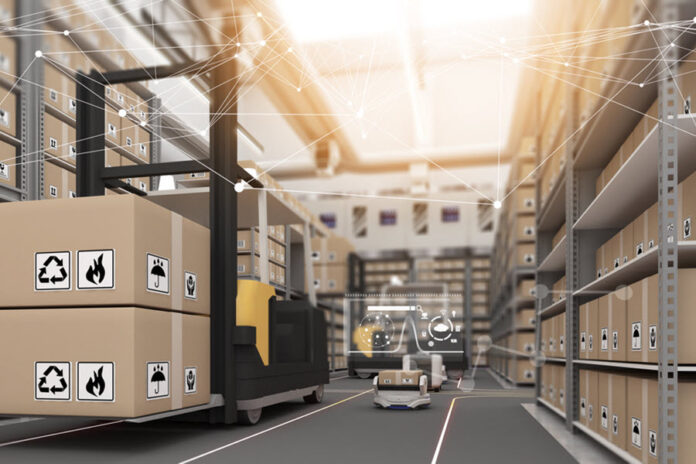Smart warehousing utilizes computer programs and machines to handle daily routine warehouse operations that were previously performed by humans. This enhances productivity and accuracy automatically. Taking advantage of implemented solutions enhances the flexibility and capability of employees and processes. In addition to reducing human error, reducing the risk of injury, and optimizing the whole process, this also reduces the total headcount, adding flexibility to the hours of work, and allowing a more accurate assessment of workforce requirements. This article discusses the available technologies for establishing smart warehouses.
Table of Contents
Warehouse Management System (WMS)
In the world of smart technology, WMS represents the tip of the iceberg. To provide a complete view of statistics and accurate planning, all of the important warehouse data was combined and gathered in one easily accessible platform. In most WMS solutions, data is gathered in real-time and visual reports are generated. Through this, any deficiencies in the processes would be apparent. As a result, businesses can make quick fixes to any problems they find and get their operations back on track after viewing the report. In addition to optimizing space and lowering operating expenses, a WMS can focus on the job’s activities while finding the right laborer to perform the task, reducing double work by scanning the items in and out as well as during their movements, and so on. To summarize, WMS streamlines the delivery workflow from inbound to outbound resulting in cost savings and improved operational efficiencies. WMS enables continuous improvements, and allows warehouse managers to constantly update new features, keeping warehouses efficient to stay current with new changes and technologies, thus incorporating new processes over time.
Internet of Things (IoT) Technology
To make this smart warehousing system work, businesses will need the Internet of Things. This technology gives an innovative answer in that it enables the monitoring, connection, and control of a vast wide variety of statistics factors via devices in a WMS. Inventory and asset tracking using sensors on the shelves that transmit information to the management system.
The use of IoT wearables devices to improve performance and promote safety by collecting information about workers at all points in the warehouse. The support of robots made automation in the warehouse particularly efficient. Deploying IoT in a warehouse can help companies improve visibility, last-mile delivery, predictive maintenance, real-time product tracking, and employee productivity.

Artificial Intelligence (AI) in Robotics
AI is gaining traction in a variety of areas, including warehousing. AI assists robots in determining the most efficient path to achieving their objectives. Based on weight, size, kind, and amount, AI can select the optimum sort of box to ship. In other words, AI is continually analyzing warehouse operations and recommending improvements. Take a peek at the different sorts of AI robots at the warehouse.

Collaborative Robots (COBOTS) is when a human and a robot work together, collaborate, to complete a process or task. Automated Guided Vehicles (AGV) are battery-powered systems consisting of multiple vehicles that navigate along a predefined path. The use of this robot helps with processing and handling throughout the plant, such as moving products through the production process, collecting assembly parts, loading pallets, and more. Autonomous mobile robots (AMRs) are motors that use processors and integrated sensors to navigate any surroundings without the want for bodily courses or markers. AMRs have a look at the surroundings and plan their course from one factor to another. Last but not least, there are automated storage and retrieval systems (AS/RS). A system, usually coupled with the WMS, controls the storage and retrieval of goods.
Automated Sortation Technology
Automated Sortation works by identifying items on conveyor systems and directing them to a specific location using software-controlled equipment. Different sorting methods are suitable for different applications depending on the sorting rate required and the product being handled. This technology gives the company a huge advantage in terms of speed and accuracy, making it one of the hottest technologies in the market today. Sorting and transporting complete cases and totes of orders is done by case sorters. They assist with reducing the amount of manual handling required to handle completed orders. As a result, the entire order cycle time is reduced. Individual objects are sorted through the facility by unit sorters. They improve the efficiency of operations throughout the order fulfillment process.
The full content is only visible to SIPMM members
Already a member? Please Login to continue reading.
References
Abby Jenkins. (2020). “Warehouse Automation Explained: Types, Benefits & Best Practices”. Retrieved fromhttps://www.netsuite.com/portal/resource/articles/inventory-management/warehouse-automation.shtml, accessed 16/09/2021.
Hunter Lowe. (2021). “Smart Warehousing: What are Smart Warehouse Systems?”. Retrieved fromhttps://www.selecthub.com/warehouse-management/smart-warehouse-systems/, accessed 16/09/2021.
Kam Pooi Foon, ADPSM. (2021). “Smart Technologies for Hotel Procurement”. Retrieved from SIPMM:https://publication.sipmm.edu.sg/smart-technologies-for-hotel-procurement/, accessed 16/09/2021.
Keane Ng, DPSM. (2020). “Key Considerations for Digital Warehousing” Retrieved from SIPMM: https://publication.sipmm.edu.sg/key-considerations-for-digital-warehousing/, accessed 16/09/2021.
Marie Ann E. Dionaldo, DLSM. (2020) “Automation Technologies for Logistics Service Providers”. Retrieved from SIPMM:https://publication.sipmm.edu.sg/automation-technologies-logistics-service-providers/, accessed 16/09/2021.
Wong Kok Fu, ADPSM. (2019). “Internet-of-Thing (IoT) Applications for Digital Procurement”. Retrieved from SIPMM:https://publication.sipmm.edu.sg/internet-of-thing-iot-applications-digital-procurement/, accessed 16/09/2021.


